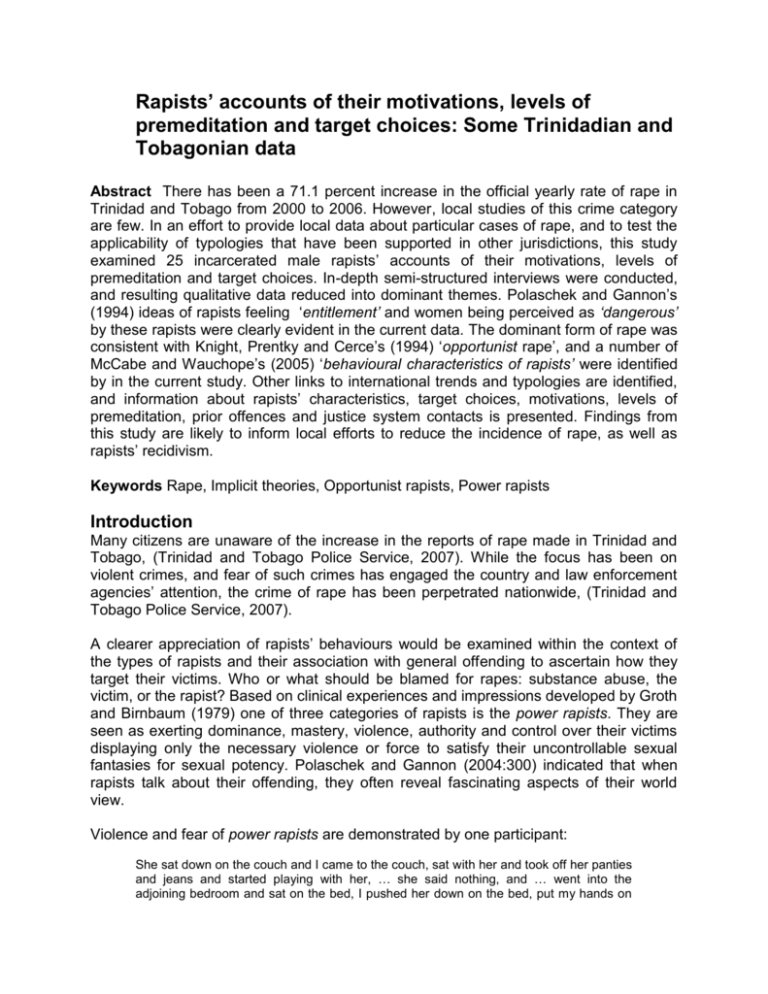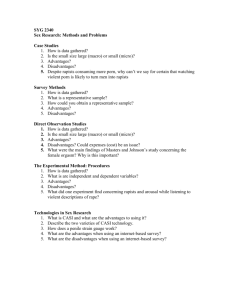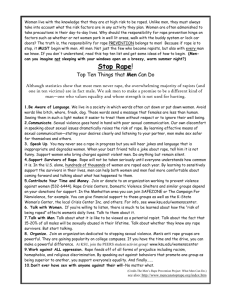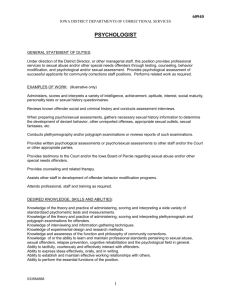
Rapists’ accounts of their motivations, levels of
premeditation and target choices: Some Trinidadian and
Tobagonian data
Abstract There has been a 71.1 percent increase in the official yearly rate of rape in
Trinidad and Tobago from 2000 to 2006. However, local studies of this crime category
are few. In an effort to provide local data about particular cases of rape, and to test the
applicability of typologies that have been supported in other jurisdictions, this study
examined 25 incarcerated male rapists’ accounts of their motivations, levels of
premeditation and target choices. In-depth semi-structured interviews were conducted,
and resulting qualitative data reduced into dominant themes. Polaschek and Gannon’s
(1994) ideas of rapists feeling ‘entitlement’ and women being perceived as ‘dangerous’
by these rapists were clearly evident in the current data. The dominant form of rape was
consistent with Knight, Prentky and Cerce’s (1994) ‘opportunist rape’, and a number of
McCabe and Wauchope’s (2005) ‘behavioural characteristics of rapists’ were identified
by in the current study. Other links to international trends and typologies are identified,
and information about rapists’ characteristics, target choices, motivations, levels of
premeditation, prior offences and justice system contacts is presented. Findings from
this study are likely to inform local efforts to reduce the incidence of rape, as well as
rapists’ recidivism.
Keywords Rape, Implicit theories, Opportunist rapists, Power rapists
Introduction
Many citizens are unaware of the increase in the reports of rape made in Trinidad and
Tobago, (Trinidad and Tobago Police Service, 2007). While the focus has been on
violent crimes, and fear of such crimes has engaged the country and law enforcement
agencies’ attention, the crime of rape has been perpetrated nationwide, (Trinidad and
Tobago Police Service, 2007).
A clearer appreciation of rapists’ behaviours would be examined within the context of
the types of rapists and their association with general offending to ascertain how they
target their victims. Who or what should be blamed for rapes: substance abuse, the
victim, or the rapist? Based on clinical experiences and impressions developed by Groth
and Birnbaum (1979) one of three categories of rapists is the power rapists. They are
seen as exerting dominance, mastery, violence, authority and control over their victims
displaying only the necessary violence or force to satisfy their uncontrollable sexual
fantasies for sexual potency. Polaschek and Gannon (2004:300) indicated that when
rapists talk about their offending, they often reveal fascinating aspects of their world
view.
Violence and fear of power rapists are demonstrated by one participant:
She sat down on the couch and I came to the couch, sat with her and took off her panties
and jeans and started playing with her, … she said nothing, and … went into the
adjoining bedroom and sat on the bed, I pushed her down on the bed, put my hands on
her chest, unzip my pants took my penis and try to put it in her vagina. She then said she
felt a sharp pain. (Offender #19).
Theorists, Knight and Prentky (1990) and Knight, Prentky and Cerce (1994), proffered a
typology, which was revised by Knight (1999). One of their four primary rapist types
typology is the opportunistic type rapists, who commit spontaneous sexual assaults by
stalking their victims and focusing on sudden enjoyment whilst using violence to control
their victims.
Another typology, according to Polaschek and Gannon’s (2004), is Entitlement implicit
theory, where rapists either forced their right to have sex whether the victim consented
or not, or displayed that they accepted their dominance over and right to control
women’s behaviour. Polaschek and Gannon (2004) also proffered Women are
dangerous implicit theory, where rapists express mistrust of women.
Can it be that rapists consume alcohol or use drugs specifically to commit their rape
acts? Abbey (1991) and Pernanen (1991) have noted that alcohol is involved in onethird to two-thirds of rapes. Langevin and Long (1990) contended that there might be
something about alcohol abuse that is related to sexual offending. In addition,
Langström, Sjöstedt and Grann (2004) explained that alcohol abuse more than doubled
the risk of recidivism amongst sex offenders.
Abracen et al. (2006) contended that sexual offenders do abuse alcohol, and suggested
that: “alcohol abuse is related to sexual offending in important ways.” One participant of
the current study narrated:
Well, that was a Friday or something. I was intoxicated as I say. I pass and pick her up in
a bar, because I know she and thing, and we went and I carry she down by my side and
ask she to have sexual intercourse, and she refused and I still went on with the
procedure, and that was it dey (Offender #21).
McCabe and Wauchope’s (2005) contend that about 25% of rapists were
acquaintances, and the rape occurred frequently at the victim’s residence. Some rapists
choose their targets based on the targets’ suitability to their type of targeting. For
Stangeland (2005) rapists' target choices were young and attractive, married women
with all victims raped on their matrimonial bed.
Whatley (2005) posits that it is important for women to pay attention to the type of dress
they wear, especially with sexually aggressive married partners. General offenders were
also identified as rapists, with a significant number of rapists raping their acquaintances.
Researching rapists’ target choices should be attempted with the use of rapists
themselves.
The definition of rape, most times, is based on legal interpretations (Tobach & Sunday,
1985). Varying interpretations of rape tend to pose problems for analysis when research
is conducted (Finkelhor & Vilo, 1982). There have been instances in the United States
where women committed rapes, and males were victims of rape (Russell, 1984;
Struckman-Johnson 1986).
Rape, for the purposes of this research, will be defined as physical, forceful, sexual
intercourse with a female person by a male person, who inserts his penis into the
female’s vagina without her consent. The slightest penetration of the vagina, even void
of emission of seed will suffice (Sexual offences Act: 308). The definition also includes
use of force by the perpetrator, where consent is given by the victim based on the
victim’s fear of bodily harm to self or another person. All attempts to commit such acts
are also deemed rape (Sexual Offences Act: 300-301).
The aim of this research is to try to determine rapists’ accounts of their motivations,
levels of premeditation and target choices with a view to understanding how rapists
formulate their acts in Trinidad and Tobago. Their modes of operations, prior interaction,
and relationships with victims were examined. It is expected to unearth evidence that
can guide policy makers in producing interventions for reducing to an acceptable level,
incidences of rape.
Methodology
Design of Study
This research took the form of a qualitative analysis of adult incarcerated rapists’
responses to a semi-structured questionnaire, together with the review of these rapists’
institutional files. They were interviewed, focusing on questions relating to basic
demographic data, prior and index offences, planning, context, location and target
choice.
The collection process occurred over a period of six weeks. The structured interviews
were recorded by the researcher who was assisted by a stenographer using a
Computer Aided Transcription (CAT) system. This system facilitated an audiosynchronised, verbatim record of the sessions. The stenographer tape-recorded the
sessions, which aided in obtaining an accurate reproduction of the interviews.
Document reviews were conducted before and after rapists’ interviews, in order to
substantiate demographic and offending data. The pre interview review enabled the
researcher to be familiar with some aspects of the rapists’ history during the interview.
Research Participants
Twenty-five incarcerated adult males, convicted of rape offences, took part in the study.
They were drawn from the Maximum Security Prison and the Carrera Convict Prison in
Trinidad and Tobago State Prison. The convicted rapists’ population of seventy-one
rapists were supplied and participants who were most recently admitted to the prison
system were first recruited to the sample followed by those who were admitted longer,
in that order, until the sample of 25 was realized.
All the rapists in the study were charged for the index offence of rape and a preliminary
enquiry of the offence was conducted for each participant before a magistrate, who
determined if there was enough evidence to convene a High Court trial before a judge
and jury. In all instances, High Court trials were conducted and participants had been
found guilty and sentenced to incarceration. However, 10 or 40% had been previously
incarcerated for violent and other serious crimes. None was undergoing psychological
treatment at the time of the study.
Procedure
Adult males who were convicted, incarcerated rapists were recruited as participants
after their Trinidad and Tobago Prison Service institutional files were reviewed. The
exclusion criteria for the study were: (1) those who committed rape offences against
children and blood relatives; (2) those who committed sexual offences that did not
involve penetration of the vagina with the penis; None of these criteria is considered
‘rape’ according to the Sexual Offences Act. (3) those whose rape charges were
pending before the judicial system. The inclusion criteria were: (1) male adult
incarcerated rapists whose act involved the use of their penis to penetrate the victim’s
vagina. (2) All attempts to commit the act, and (3) in terms of gender, all victims had to
be females.
The focus of the interviews was to have participants explain the whole rape act and to
recount all the actions, feelings and behaviours they displayed during that period. There
were five main categories of questions. These were: prior offences; circumstances;
planning and premeditation; victim factors, and motivation.
Results
Prior Offences
Ten members of the sample had been previously incarcerated for offences ranging from
simple larceny to serious offences such as robbery. The length of prior incarceration
ranged from 1 to 5 years (see Table 1) with 50% of those previously incarcerated
having served 2 to 4 different sentences. This gives support to power rapists use of
violence, with 12% of the sample stating they committed over 100 undetected offences
and another claimed to have committed between 200 to 300 offences undetected.
Table 1: Participants’ previous official offending
Offender #
2
11
13
15
16
17
18
22
25
Years served
2½
5
2
3 months
1½
5
1
2
2
Frequency Incarcerated
1
2
1
3
3
2
1
4
1
Circumstances
Participants’ responses to questions about the circumstances of the index offence and
when it was committed placed participants into three categories: deniers, admitters and
refusers. Denial of committing offences is not a new occurrence in rape research, and
can vary. For example, Langevin et al’s (2004) sample of 320 sex offenders, 90.5%
admitted to committing the marked offences, whilst Polaschek and Gannon’s (2004:309)
sample of 37 rapists, indicated that:
A key feature of rapists’ account of their offenses is whether or not they admit they
committed a rape. Often, men who deny committing rape may not be considered suitable
for treatment.
A significant part of the present sample (76%) denied guilt for their proven index
offences (see Table 2).This fits into Polaschek and Gannon’s (2004:306) implicit theory
of women are dangerous. They proffered that:
The high prevalence of this particular theory was particularly noticeable among deniers,
who mostly portrayed their victims as accusing them of rape to get back at them for trivial
misdemeanour, or because otherwise the victim would be in trouble with her boyfriend for
having sex with another man.
This has emerged in the current research as one participant’s explanation for being
charged with the index offence stated:
Well it is a little friend I used to deal. That night I end up dropping she home late on that
occasion. But she boyfriend was home and he get angry because ah drop she home late
and he and she brother beat me up, take meh car keys…. I decide to go and report it in
the station. They tell she to get even with me, if ah going to lock them up - gee them
case. She hah to say, well ah commit this offence. That is what transpired (Offender# 7).
Another indication of implicit theory - women are dangerous as shown by Offender #9,
who claimed to be fooled by a young victim, is as follows:
The person I get myself involved with, the first thing, they lied to me about their age. The
person tell me they was 23 years old. Well, we start seeing each other and we end up
having sex. Someone saw us when we was coming from where we were, and they went
and talk to their mother. Then when I was charged with that incident is the only time I
knew she was 16 years.
According to Polaschek and Gannon’s (2004) implicit theory, rapists usually provide
insight into their beliefs and perceptions whether or not they admit that their sexual
behaviour was of a criminal nature. Offender #9 denied having committed the index
offence, based on his belief that consent was given by the victim whose age was under
that required for statutory sexual consent.
Table 2: Participants’ response to Index offence committal
Response
Deniers
Admitters
Refuser
Frequency
19
5
1
Percentage
76
20
4
Twenty percent of participants who admitted committing the index offence showed
evidence of women are dangerous implicit theory. Offender #10 stated that:
Okay, I get lock up for rape, but I would like to say this also, this was consent, but the fact
remains that the youth was a teenager at the time. It wasn’t anything like force or
anything like that.
Planning and Premeditation
Lussier, Proulx and LeBlanc (2005) indicated that sexual aggression can occur during a
burglary in which theft was the initial motive. A significant finding is that 23 of the
participants or 92% stated they did not plan to rape their victims whilst 84% did not
choose the time of the day they raped - this is the behaviour of the opportunist rapist
according to Knight, Prentky and Cerce (1994). Some participants narrated:
How you mean choose the time of the day? It happen. We accustom (Offender #7).
No, it just happened. We didn’t choose no particular time (Offender #12)
This girl was a girl who used to be around on the block and under a low she would come
out certain times in the night (Offender #20).
It was found that victims’ home emerged as the most frequently used place (see Table
3). This supports the findings of McCabe and Wauchope (2005) behavioural
characteristics of rapists that a large number of rapes take place at victims’ home.
Victim’s home
7
28%
Table 3: Place where the index rape occurred
Rapist’s home Vehicle Lonely place Hospital
6
2
3
1
24%
8%
12%
4%
Other
6
24%
In addition, Stangeland’s (2005:456) study of a serial rapist of 29 admitted rapes, stated
that:
“The victims were always married, young and attractive, and all assaults took place in
their own home.”
The current research found that 7 participants or 28% committed the rapes at the
victims’ home. For example, this participant indicated that:
Well, it happen in the woman house. It wasn’t nowhere out the road to say it happen in
the road (Offender #24).
Some participants gave various replies about committing the index offence supporting
implicit theory, ‘Entitlement’. According to Polaschek and Gannon (2004), it refers to the
idea that one’s needs, inclusive of sexual needs, should be met as requested. A few
selected lonely places to commit the index offence. One stated:
Wherever I reach them up, once is a lonely place, I will just take them (Offender #23).
Another of the sample who chose a lonely place narrates:
Coincidentally you try to get her in a secluded place; you always having her in places, but
this trip it’s in a secluded place and you really want; you don’t want to turn back (Offender
#25).
Rapists’ activities in Trinidad and Tobago showed that the majority of their targeting is
centred on victims known to them. This can assist enforcement officials and would-be
victims to be alerted to their acquaintances’ behaviours and activities. Eighteen or 72%
of the participants reported to have raped their acquaintances. For example:
Yes. We met in the church (Offender #18); and
They always around (Offender #2).
For 19 or 76%, location features were not important to them suggesting that the majority
of the sample operated spontaneously as opportunities arose - a prime feature of the
opportunist rapists. Some responses are:
It took place right home by me (Offender #8)
It wasn’t a place that was selected, it was a place I normally does be (Offender #9)
I really didn’t select any place. It is just at the point of the time where we were and when
the incident happened I participate (Offender #12)
It is clear that opportunist rapists disregard planning for locations and strike at their prey
with despatch.
A vast number of rapists (23 or 92%) behavioural characteristics showed they did
not intend to rape on the onset. One of the respondents appeared to have been
overwhelmed by the appearance of the victim and stated that:
Like I said, my plan was not to rape. Just at the point at the time when everything
happened, the way she looked and whatnot, it turned me on (Offender #12).
Another participant tells his piece:
I didn’t intend to rape, but commit other offences, shoot the men them, chop them up,
burn down the house, rob them (Offender #17).
Almost all the respondents did not plan to rape initially, which suggests that they would
have acted based on the opportunity as it arose. Knight, Prentky and Cerce (1994)
noted that the opportunistic type rapist commits impulsive, predatory sexual assaults,
and violence is used to constrain the victim. Offender #23 displays such behaviour,
indicating that:
In the night now, I will go prowling. Sometimes I meet up no one, when I reach up
another woman. Ah throw her over a cliff, skate her knee and had sexual intercourse
with her. In my heart is to take her life, but after ah discharge ah take her and bring she
back up the road. The urge is not to destroy her, just to have meh desire quench.
This revelation is also consistent with Knight et al’s (1999) notion of power rapists those who exert strength, authority and control over their victims. Participants gave
different reasons for choosing victims they raped. One participant displaying power
rapists’ behaviour, stated briefly and fearlessly:
I just going hunting (Offender #23).
Victim Factors
Responses to dress, complexion and desire had an impact on one rapist’s choice to
rape. Question 23: Were there aspects of how the victim dressed that ruled her out as a
possibility? Reply:
Well you can’t stop that. Once they dress…sometimes dressing have a lot to really ketch
the imagination. You can’t stop that.
Exposure of the body seems to be an enticement for some rapists, whilst others felt
short pants contributed to the rape. Rapists’ comments:
She had on a short pants and a short top. She like sexy thing; a nice thing; a best thing. I
does only go around best thing. You know wha ah mean nah. They mightn’t be best in
attitude and thing. You know what I talking about (Offender #7).
She had a little short pants and no underwear, and that
what cause it (Offender #3).
Yes. For instance a J’Ouvert morning wear.[Laughing] Short fitting pants, piece a top,
exposed, yuh seeing flesh (Offender #15).
Rapists - 12 or 48% - stated that features do matter and various reasons were given.
Women’s shape, breast, buttocks and hip were appealing to some of them:
I like to see a woman hip. I like to see she hip. [Laughing] Ah like to see hip with small
chest. [Laughing] (Offender #14)
Little piece ah tail; shapeted; must be looking good. Piece ah ass (Offender #15).
Shape, hips part, chest part, a lil face and thing. Beauty in them (Offender #17).
The three above participants have supported Whatley’s (2005) finding that the way
women dress can affect rapists’ desires. Victim is deserving of some blame…victim
dressed in a seductive manner deserved more responsibility for the incident than the
victim dressed in a sober manner (Whatley 2005:197). Thus, women’s physique seems
to play an important part in choices rapists make when they rape.
Substance abuse was highlighted by Abracen et al (2006). They contend that a history
of drug abuse is common to rapists and violent offenders. In one case the participant
claimed, body exposure, alcohol and smoking contributed, whilst another claimed to
have used both alcohol and marijuana.
Yes, the flesh was exposed. At that point in time we were drinking alcohol and smoking. It
turns you on (Offender #12).
Up in Caura extension,… And I later have a relationship with the woman under the
influence of marijuana, well, no, well I went up together by the river, and we was smoking
weed. We was smoking weed and we was drinking homemade wine (Offender #1).
In the case of another participant, he indicated that:
Ah realize smoking cocaine was getting the better half of me, ah say boy, ah cyah leh
meh friends, meh people and them see meh doing this (Offender # 20).
In the present research, substance abuse by rapists supports the findings of Langevin
and Lang (1990) who stated that sexual offenders experience great problems with
substance abuse. Abracen et al. (2006) also suggested that: “alcohol abuse is related to
sexual offending in important ways.” This participant said:
I was really intoxicated at the time when this incident take place...intoxicated with alcohol.
Well, that was a Friday or something. I was intoxicated as I say. I pass and pick her up in
a bar, because I know she and thing, and we went and I carry she down by my side and
ask she to have sexual intercourse, and she refused and I still went on with the
procedure, and that was it dey. Ah didn’t get hold the same day, but three days after
(Offender # 21).
Motivation
In choosing a target, one participant’s choice was made by the need to rape, and
sought his victim based on his sexual desire. His behaviour, although having power
rapists’ characteristics, supports the findings of Knight, Prentky, and Cerce’s (1994)
opportunistic type rapist:
Ah come down and ah gone down on the beach, and when I walking on the beach ah see
a young girl name (victim named). After ah walking on the beach, ah reach (victim
named), someone ah know quite well, but the urge in me to have sexual intercourse and
so on, ah run up to her and ah lock her neck, and ah told her, ah know you ain’t know
who is this. She say (participant named), you is a man with a intellect, you does speak
so fine, you could get any woman you want. Ah say, girl all I want to do is for you to have
sexual intercourse with me (Offender # 23).
A large number, 18 or 72% of the sample, did not expect to be caught, whilst 100% did
not weigh the potential of punishment before raping. This suggests that a high number
of rapists,’ raped mostly when the opportunity arose, giving a fit to Knight, Prentky and
Cerce’s (1994) opportunist rapist. For example:
I wasn’t thinking of being caught at that time (Offender #12).
I didn’t think about any punishment because I never had any mind coming to prison
(Offender #4)
Me ain’t looking out for no punishment, because the person affiliated to me (Offender
#25)
Also unearthed are power rapists’ feelings displayed towards their rape victims:
I didn’t have no mercy. I really ain’t feel good, but I was vex. Yes, it was revenge.…Not
really. [response to jealousy] As I say, is hurt I really went to hurt them (Offender #16).
Yes, I had, but I just couldn’t bring it out. You know when I rape she, better ah take she
life, but as ah done discharge, that passion would go and ah would assist them up
(Offender #23).
Offender #23 felt he was entitled to have sex even against the victim’s desires and
gives support to ‘entitlement’ implicit theory that proffers, offenders insist on their right
to have sex regardless of the victim’s consent or not (Polaschek and Gannon 2004). An
unusual rapist’s behaviour emerged as a result of a contract given to rape one victim.
He narrated:
As ah tell yuh before, it was a pay work, and the person identify the person; they pass in
the car, they identify the person and tell me this is the person they want me mash up and
dat is how it drag out. Whether a rape or murder or whatever it could be, once the person
want the work finish, and they pay they money, half ah the money and you do the work,
they carry you and they show yuh which part the person living, and within two to three
weeks the work complete you go and collect yuh rest a money (Offender #24).
In terms of controlling sexual desires, 23 (or 92%) stated they could control such
desires but one respondent reported he couldn’t control the desire. He stated:
It was just at the point of time I was there and the way she was exposed, it just came into
my mind and I felt that I had to have her. Knowing that I had the power knowing we had
her as hostage, I committed the act (Offender #12).
Evidence of Knight, Prentky and Cerce’s (1994) opportunist rapists emerged numerous
times, with Implicit theories emerging to a lesser extent. In addition, Abracen et al.
(2006) findings that: “alcohol abuse is related to sexual offending in important ways”
support the findings of substance abuse in this research. There was some evidence of
McCabe and Wauchope’s (2005) typology that indicated rapes occurred regularly in the
victims’ homes. Power rapists were also noticeable in the current study.
Rapists in the research reported that they had also committed general offences and a
significant number raped their acquaintances, as supported by Stangeland’s (2005).
Another finding was that rapists are attracted to women who wear short pants as
posited by Whatley (2005).
Limitations
Participants recruited were not rape recidivists, thus generalizations may not be reliable.
Lengthy waiting periods for participants’ trials might have had an impact on participants’
memory. Surprisingly, however, participants who were incarcerated longest gave richer
narrations of their encounters.
Many respondents have been incarcerated for longer than three years, which may have
affected the accuracy of their responses. Also, a few repeat rape offenders were
unavailable. They might have been a more interesting group for such a research.
Although recording of the interviews may have inhibited responses, the accuracy of
quotes is guaranteed. This research is the first of its kind in the region and all possible
respondents were sourced. Qualitative approach facilitated collection of full narratives
and aided theory building.
Future Research
Future research should be conducted using recent offenders, chronic offenders, and
various types of offenders.
Respondents’ accounts of the index offence should be compared with that of victims.
Victims’ narrations of the sample index offence should be analysed.
Research should be conducted into the high incidences of acquaintance-victims’ rapes,
also into geographic location and community factors of the sample.
Implications
It is hoped that this research would sensitize would-be victims about different types of
rapists and their preferences, such as young women, scantily dressed women, and
women who abuse substances.
Law enforcement investigators should not rule out general offenders and abusers of
alcohol and drugs, as rape suspects.
Citizens should be alerted to but not alarmed at the areas in which rapes are prevalent,
and should be careful of acquaintances and strangers in their homes.
Knowledge of the aforementioned types of rapists can assist investigators in their
understanding of rapists’ behaviours.
Rape prevention initiatives can be developed through education and policy formulation
driven by the results of the research.
References
Abracen, J., Looman, J., De Fazio, R., Kelly, T. and Stirpe, T.2006. Patterns of
attachment and alcohol abuse in sexual and violent non-sexual offenders.
Journal of Sexual Aggression, Vol. 12. No. 1, pp. 19-30.
Clarke, S.2007.Asistant Superintendent of prisons Personal interview. July 20.
Garofalo, J.1987.“Reassessing the Lifestyle Model of Criminal Victimization” in
Positive Criminology, eds., Michael Gottfredson and Travis Hirschi (Newbury
Park, CA: Sage, 23-42.
Groth, N., and Birnbaum, H. 1979. Men who rape. New York: Pleunum.
Knight, R. A.1999. Validation of a typology for rapists. Journal of Interpersonal
Violence 14, 303-330.
Knight, R.A. and Prentky, R.A. 1990.. Classifying sexual offenders: The development
and corroboration of taxonomic models. In W.L. Marshall, D.R. Laws, & H.E.
Barbaree (Eds.), Handbook of sexual assault: Issues, theories and treatment of
the offender (Applied clinical psychology 23-52. New York: Plenum.
Knight, R.A., Prentky, R.A. and Cerce, D.D. 1994. The development, reliability, and
validity of an inventory for the multidimensional assessment of sex and
aggression. Criminal Justice and Behavior, 21, 72-94.
LaGrange, T. 1999, “The Impact of Neighbourhoods, Schools, and Malls on the Spatial
Distribution of Property Damage” Journal of Research in Crime and
Delinquency 36 393-422.
Langevin, R., Curnoe, S., Fedoroff, P., Bennett, R., Langevin,. M., Peever, C., Pettica,
R. and Sandhu, S.2004. Department of Psychiatry, University of Toronto.
Langevin, R. and Lang, R.A. 1990. Substance abuse among sex offenders. Annals of
Sex Research, 3, 397-424.
Langström, N., Sjöstedt, G. and Grann, M. 2004. Psychiatric disorders and recidivism
in sexual offenders. Sexual Abuse: A Journal of Research and Treatment, 16,
139-150.
Lussier, P., Proulx, J. and LeBlanc, M.2005. Criminal propensity, deviant sexual
interests and criminal activity of sexual aggressors against women: A
comparison of explanatory models Criminology Vo. 43 No.1
Matthews, S.2007. Senior Superintendent of Maximum Security Prisons, personal
interview July 20.
McCabe, M.P. and Wauchope, M.2005. Behavioural characteristics of rapists. Journal
of Sexual Aggression. Vol. 11, No. 3. 235-247.
Morgan, R.2007. Assistant Superintendent of Prisons. Carrera Convict Prison.
Personal interview. July 28.
Polaschek, D.L.L. and Gannon, T. A. 2004. The Implicit Theories of Rapists: What
Convicted Offenders Tell Us. Sexual Abuse: A Journal of Research and
Treatment, Vol. 16, No. 4, October, 309.
Polaschek, D.L.L. and Ward, T.2002. The implicit theories of potential rapists: What
our questionnaires tell us. Aggression and Violent Behaviour, 7.385-406.
Prentky, R.A., and Knight, R.A. 1991.. Identifying critical dimensions for discriminating
among rapists. Journal of Consulting and Clinical Psychology, 59, 643-661.
Russell, D. E. 1984.. Sexual exploitation. Beverly Hills, CA: Sage.
Sexual Offences Act, Chapter 11:28, Laws of Trinidad and Tobago.
Stangeland, P.2005. Catching a Serial Rapist: Hits and Misses in Criminal Profiling
Police Practice and Research. Vol. 6, No. 5 453-469.
Testa, M., VanZile-Tamsen, C. and Livingston J.A.2007. Prospective Prediction of
Women’s Sexual Victimization by Intimate and Non-intimate Male Perpetrators
Journal of Consulting and Clinical Psychology Vol. 75 No. 1, 52-60.
Tobach, E. and Sunday, S. R. 1985. Epilogue. In S. R. Sunday & E. Tobach (Eds.),
Violence against women. (pp. 129-158). New York: Gordian Press.
Trinidad and Tobago Police Service 2007. Unpublished sexual offending statistics
2007.
Turner, S. 1969. Delinquency and distance. In M. E. Wolfgang and T. Sellin (Eds.),
Delinquency: Selected studies. 11-26. New York: Wiley.
Ward, T 2000., Sexual offenders’ cognitive distortions as implicit theories, Aggression
and Violent Behavior, 5 491-507.
Whatley, M. A. 2005. The Effect of Participant Sex, Victim Dress, and Traditional
Attitudes on Causal Judgments for Marital Rape Victims, Journal of Family
Violence, Vol. 21 No. 3.
Yegidis, B. L 1986. Date Rape and other forced sexual encounters among college
students. Journal of Sex Education and Therapy, 12 51-54.








